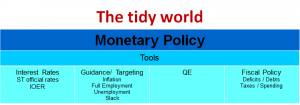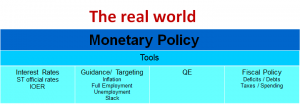James Alexander via Historinhas | I have been away on vacation. Unlike the BoE’s Kristin Forbes I haven’t come back with a homily about the need to wear suntan lotion as a good analogy for monetary policy. Walking along, or rather up and over, the Amalfi Coast did make me very much acquainted with concrete steps as well as the beautiful views.
The effort of walking up all those steps did set me thinking about monetary offset as my muscles wearied. Analogies of pushing water uphill also came to mind as I lugged several plastic bottles of water around. It made me think of my earlier matrix that tried to distinguish various economic states dependent on the stance of monetary and fiscal policy. While helpful, I think it was also somewhat misleading.
On another view, there is only monetary policy, defined as the value of money relative to real goods and services. All else is just tools: official short term policy rates, IOER, targeting or guidance, QE, fiscal policy.
Scott Sumner has been dogged in drawing attention to the fact of “monetary offset”, whereby the tool of expansionary fiscal policy is offset if the overarching policy tool is inflation targeting. Monetary policy will stay tight if the market believes the central bank thinks their inflation target is at risk under the expansionary fiscal policy. The riskiness of an expansionary fiscal policy is moot, but if the market believes the central bank is concerned then the policy will be offset.
Market Monetarists have gone further and shown how the targets morph into ceilings with terribly depressing results on inflation, but unconcerning to the central bankers.
The theory of monetary offset can also apply to “monetary” tools themselves. The intended help given to an economy from low official interest rates can also offset by those, more important, inflation targets. Paying IOER offsets the impact of low official rates. QE will be offset by strict inflation targeting. Using the targets of “full employment” or “lack of slack”, ie the once discredited Philips Curve, will also offset the benefits of other monetary policy tools.
Formal models like to work with concrete things, like the actual level of official rates, the actual level of employment/unemployment, the targeted “inflation rate”, the actual amount of QE, the actual amount of deficit spending or the actual size of the debt. But all these actuals come into conflict,and can and do offset each other. In Brazil at the moment fiscal expansion is beginning to offset inflation targeting as Marcus Nunes has recently shown. When that happens the monetary policy is effectively set to high or even hyper nominal growth, most of it or even all of it inflation.
So many tools, so many offsets actually leads to a kind of policy chaos
The big point here is that, more than ever, the monetary policy is whatever society (or the market or economic participants) believes it is, not what officials say it is. Central bank officials like to bang on about “credibility”, and in a way they are right. It is what the society believes about the central bankers’ goals that matters, that influences economic activity: spending, saving, working, investing.
If society believes they are poodles of an irresponsibly expansionist and corrupt government then we know what happens. If society believes they are, like today, prisoners to a bankrupt theory like the Philips Curve then the goals will be very unclear and society will grasp at whatever seems to be uppermost in the minds of those in charge. Hence. we see the constant and detailed parsing of every speech or interview given by the policy makers. It is a social position that many seem to rather enjoy, and even milk for their own private benefit, especially once they’ve left office.
The tidy world chart is too formal. The real world is the tidy world but enveloped in a cloud of expectations about what the future holds for monetary policy, which tools will be pre-eminent and for how long. And this just serves to emphasise the central role of expectations in monetary policy, especially when the tools are so numerous and the policy is so vague.
Keep It Simple Stupid
Market Monetarists believe that the policy makers should go back to basics and simply target stable expectations for the growth rate for the nominal economy, or NGDP forecasts. It’s a highly prudent and responsible policy and very transparent, far more so than targeting inflation, “full” employment or worse the output gap or “slack”.
The tools by which they choose to achieve that goal are not that relevant. The central banks can then step out of the limelight and leave economics and politics to debates over micro-economics.
*Image: 16:9clue







